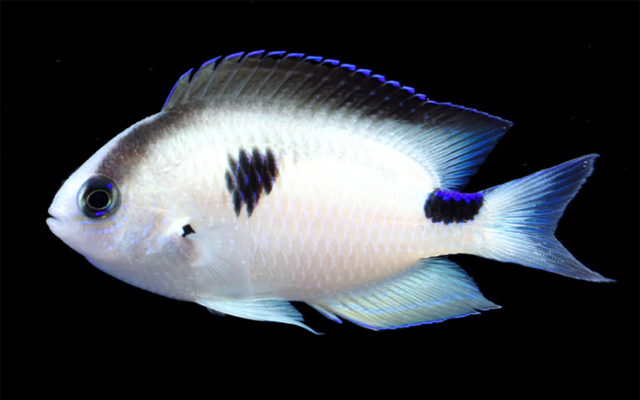
Scientists Identify New Species of Damselfish
New study co-authored by Scripps Oceanography identifies Corazon’s Damsel, a previously unknown species of damselfish found off Madagascar
Published Date
By:
- Brittany Hook
Share This:
Article Content
Scientists at Scripps Institution of Oceanography at the University of California San Diego and the University of Sydney, Australia have identified a previously unknown species of damselfish from Madagascar.
The new species, named Corazon’s Damsel or Pomacentrus vatosoa, is described by co-authors Ben Frable and Yi-Kai Tea in the June 10 issue of the scientific journal Copeia.
Damselfishes are a diverse group of small to medium-sized fishes that occur throughout the tropics and subtropics. Measuring approximately five centimeters (two inches) in size, the distinctive damselfish described in the new paper has a pearlescent-white body color and two prominent black spots—one situated behind the pectoral fin near the middle of the body, and the second saddled on the upper edge where the tail fin connects to the body. Its striking features caught the eye of commercial divers working on Nosy Faho, a reef off the northeastern coast of Madagascar, in December 2018.
After collecting the unknown fish, the divers contacted Tea, an expert on coral reef fishes and a systematic ichthyology PhD candidate at the University of Sydney’s School of Biological Sciences, to get a species identification. Tea had not seen anything like it before so he reached out to several veteran ichthyologists, including damselfish expert Gerry Allen with the Western Australia Museum, who confirmed that the species in hand was indeed a new, undescribed species. Having recently collaborated with Frable, collection manager of marine vertebrates at Scripps Oceanography, Tea asked if he would like to collaborate again in investigating the unknown species.
The ichthyologists worked together to compare specimens and genetics of potentially closely related species and confirmed that this damselfish is a previously undiscovered and undescribed species. They used molecular sequencing data to compare genetic relationships and conducted a morphological examination to look at the form and structure of the fish’s teeth, bones, body dimensions, and scales. They concluded that the fish is a new species of the damselfish genus Pomacentrus, not the genus Chrysiptera as it had been previously identified by the reef aquarium community.
“I think the most exciting aspect about this description is that Corazon’s Damsel doesn't look very similar to any previously known fish species,” said Frable. “It was also collected near a city and at a relatively accessible depth of 45-60 feet. Most new reef fish discoveries are coming from much deeper—the mesophotic reef—below 200 feet.”
The authors noted their surprise that the stunning fish remained undetected for so long in a region that has been surveyed extensively in the past.
“The fact that a new species with distinctive coloration can go unnoticed is a stark reminder that there’s still much to learn about coral reef diversity and our oceans as a whole,” said Tea.
The authors decided to name the species Pomacentrus vatosoa because vatosoa is a Malagasy word meaning "beautiful stone," a term sometimes used in reference to opals or pearls that seemed fitting to describe the opalescent or pearlescent appearance of the fish. The common name was selected in honor of Corazon Sibayan Shutman, wife of Barnett Shutman—the person who provided the researchers with the fish specimens.
One of the four specimens used in this study is now housed at Scripps Oceanography’s Marine Vertebrate Collection, an archive of approximately 2 million alcohol-preserved specimens representing more than 5,600 species of fishes. The collection supports scientific research by providing specimens for studies on the taxonomy, evolution, and ecology of fishes.
Frable said that in the past year alone, collection staff have described five new fish species—three of which he worked on. He said there are usually between 300-500 new fish species described worldwide every year. There had been 138 new species described in 2019 thus far; Corazon’s Damsel marks 139.
Share This:
You May Also Like
Stay in the Know
Keep up with all the latest from UC San Diego. Subscribe to the newsletter today.



